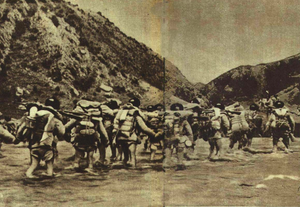
Back معركة شامدو Arabic Чамдоская аперацыя Byelorussian চামদোর যুদ্ধ Bengali/Bangla Invasió xinesa del Tibet Catalan Battle of Chamdo English Anexión del Tíbet por China Spanish Kiinan–Tiibetin sota Finnish Intervention militaire chinoise au Tibet French Kineska invazija na Tibet Croatian Invasion del Tibet 1950-1951 Interlingua
| Chinesische Eroberung Qamdos | |||||||||||||||||
|---|---|---|---|---|---|---|---|---|---|---|---|---|---|---|---|---|---|
| Teil von: Annexion Tibets durch die Volksrepublik China | |||||||||||||||||
 Truppen der Volksbefreiungsarmee überqueren den Mekong | |||||||||||||||||
| Datum | 6. bis 24. Oktober 1950 | ||||||||||||||||
| Ort | Qamdo, Tibet | ||||||||||||||||
| Ausgang | chinesischer Sieg | ||||||||||||||||
| |||||||||||||||||
Die Chinesische Eroberung Qamdos (chinesisch 昌都战役, Pinyin Chāngdū zhànyì, Qamdo-Feldzug) war eine militärische Expedition in der frühen Geschichte der Volksrepublik China im Oktober 1950.[9][10] In dem zweiwöchigen Feldzug der Volksbefreiungsarmee, dem mehrmonatige ergebnislose Verhandlungen über den Status Tibets vorausgegangen waren,[11] wurde die Region Qamdo des de facto unabhängigen Staates Tibet[12][13][14] erobert und nach weiteren Verhandlungen zwischen der Volksrepublik und tibetischen Vertretern im Mai 1951 das Abkommen zur friedlichen Befreiung Tibets geschlossen, das zur Annexion Tibets führte.[15]
- ↑ Mackerras, Colin. Yorke, Amanda. The Cambridge Handbook of Contemporary China. [1991]. Cambridge University Press. ISBN 0-521-38755-8. S. 100.
- ↑ a b Melvyn C. Goldstein: A history of modern Tibet, 1913–1951, the demise of the lamaist state. University of California Press, 1991, S. 639.
- ↑ 14. Dalai Lama: Freedom in Exile: The Autobiography of the Dalai Lama, London: Little, Brown and Co, 1990 ISBN 0-349-10462-X
- ↑ Laird 2006 S. 301.
- ↑ Shakya 1999, S. 43
- ↑ a b Jiawei Wang und Nima Gyaincain, The historical Status of China's Tibet, China Intercontinental Press, 1997, S. 209 (siehe auch The Local Government of Tibet Refused Peace Talks and the PLA Was Forced to Fight the Qamdo Battle, china.com.cn): „The Qamdo battle thus came to a victorious end on 24 October, with 114 PLA soldiers and 180 Tibetan troops killed or wounded.“
- ↑ Shakya 1999, S. 45. Shakya zitiert auch chinesische Quellen, die 5738 feindliche Kombattanten als „liquidiert“ und über 5700 als „vernichtet“ angeben. Shakya macht keine Angaben zu chinesischen Verlusten.
- ↑ Feigon 1996, S. 144.
- ↑ Chinese Reds Promise the 'Liberation' of Tibet. In: The New York Times. 3. September 1949 (Online).
- ↑ Hinweis: Die Tibetische Exilregierung in Indien benennt die Schlacht als "...Invasion Tibets durch die chinesische Volksbefreiungsarmee", siehe Tibet: Proving Truth From Facts. The Status of Tibet: "At the time of its invasion by troops of the People's Liberation Army of China in 1949, Tibet was an independent state in fact and by law."
- ↑ Shakya 1999, S. 28–32.
- ↑ Tsering Shakya, Dragon in The Land of Snows: The History of Modern Tibet since 1947, Random House, 2012, Google e-book: "Tibet had never received de jure recognition from any state; in any case such recognition would be disputed not only by Beijing but also by the nationalist regime in Taiwan.
- ↑ Stephanie Roemer, The Tibetan government-in-exile: politics at large, S. 32: "the Tibetans signed the so-called 'Seventeen Point Agreement', where they officially acknowledged the Chinese intentions to liberate Tibet, which meant the end of Tibet's de-facto independence."
- ↑ John Kenneth Knaus, Orphans of the Cold War: America and the Tibetan struggle for survival, S. 84: "The seventeen points of the agreement ended the de facto independence of Tibet."
- ↑ Tibet Justice Center - Legal Materials on Tibet - China - Seventeen-Point Plan for the Peaceful Liberation of Tibet (1951) p.182. Abgerufen am 29. Januar 2024.
© MMXXIII Rich X Search. We shall prevail. All rights reserved. Rich X Search